BUSI 2133: Case Study - Change Management Challenges at DRDC Toronto
VerifiedAdded on 2022/08/20
|9
|2195
|14
Case Study
AI Summary
This case study examines the change management challenges at DRDC Toronto, a research center focused on human effectiveness for Canadian Defence and National Security. The assignment analyzes the challenges faced by the organization during its 'change journey,' which aimed to integrate scientific expertise and become more relevant to military clients. The study explores challenges such as defining roles, integrating external consultants, and transitioning from siloed to client-based activities. Furthermore, it assesses the Professional Partnership Initiative (PPI), a plan proposed by Mr. Pigeau, the change agent, involving four departments: corporate, administration, technical, and science. The analysis considers the perspectives of different stakeholders within the PPI and the importance of vertical and horizontal dimensions in ensuring the initiative's success. The case highlights the need for effective leadership and clear goals to foster collaboration and achieve organizational objectives. Ultimately, the case underscores the importance of aligning individual and common goals for the success of the DRDC Toronto organization.
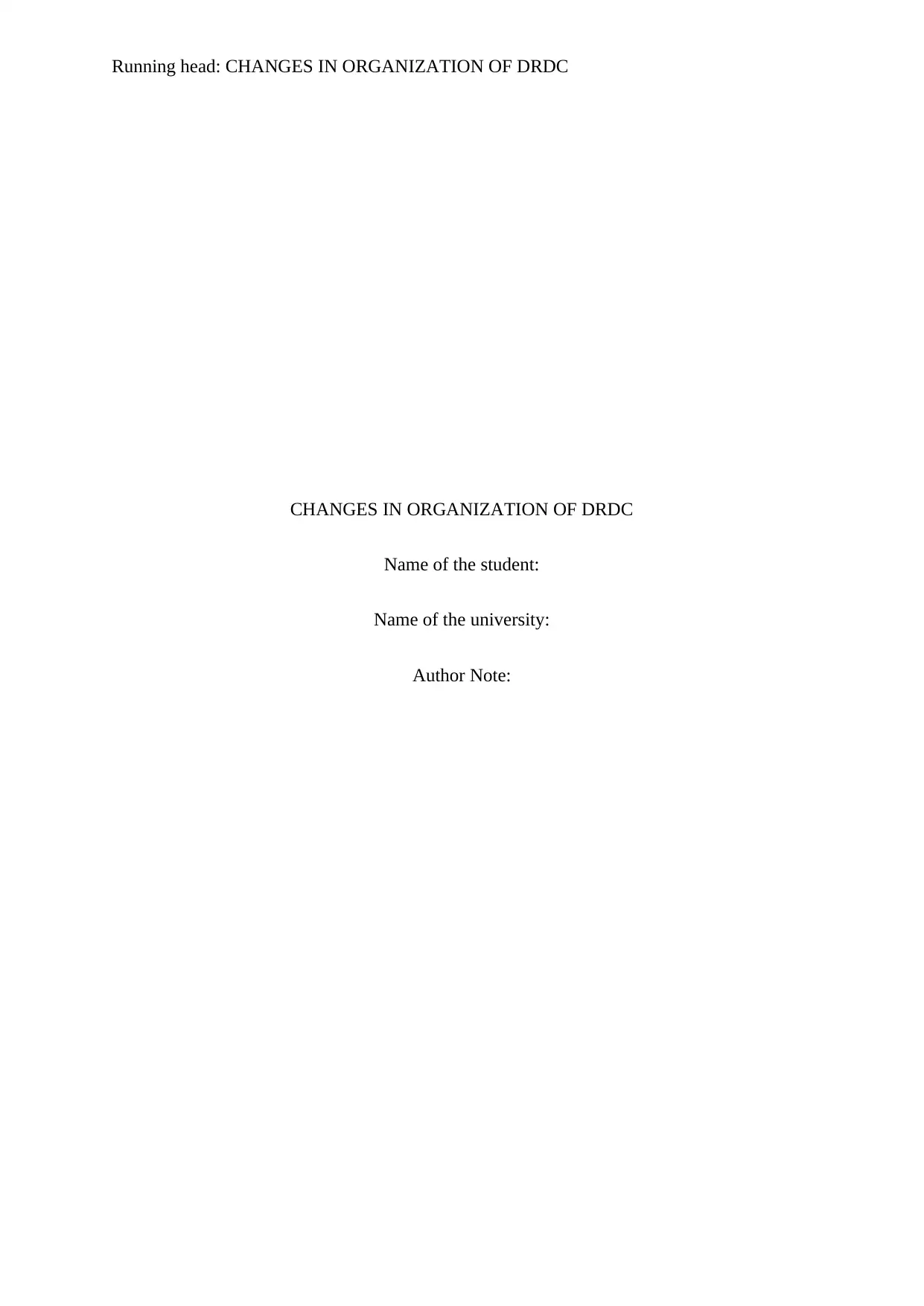
Running head: CHANGES IN ORGANIZATION OF DRDC
CHANGES IN ORGANIZATION OF DRDC
Name of the student:
Name of the university:
Author Note:
CHANGES IN ORGANIZATION OF DRDC
Name of the student:
Name of the university:
Author Note:
Paraphrase This Document
Need a fresh take? Get an instant paraphrase of this document with our AI Paraphraser
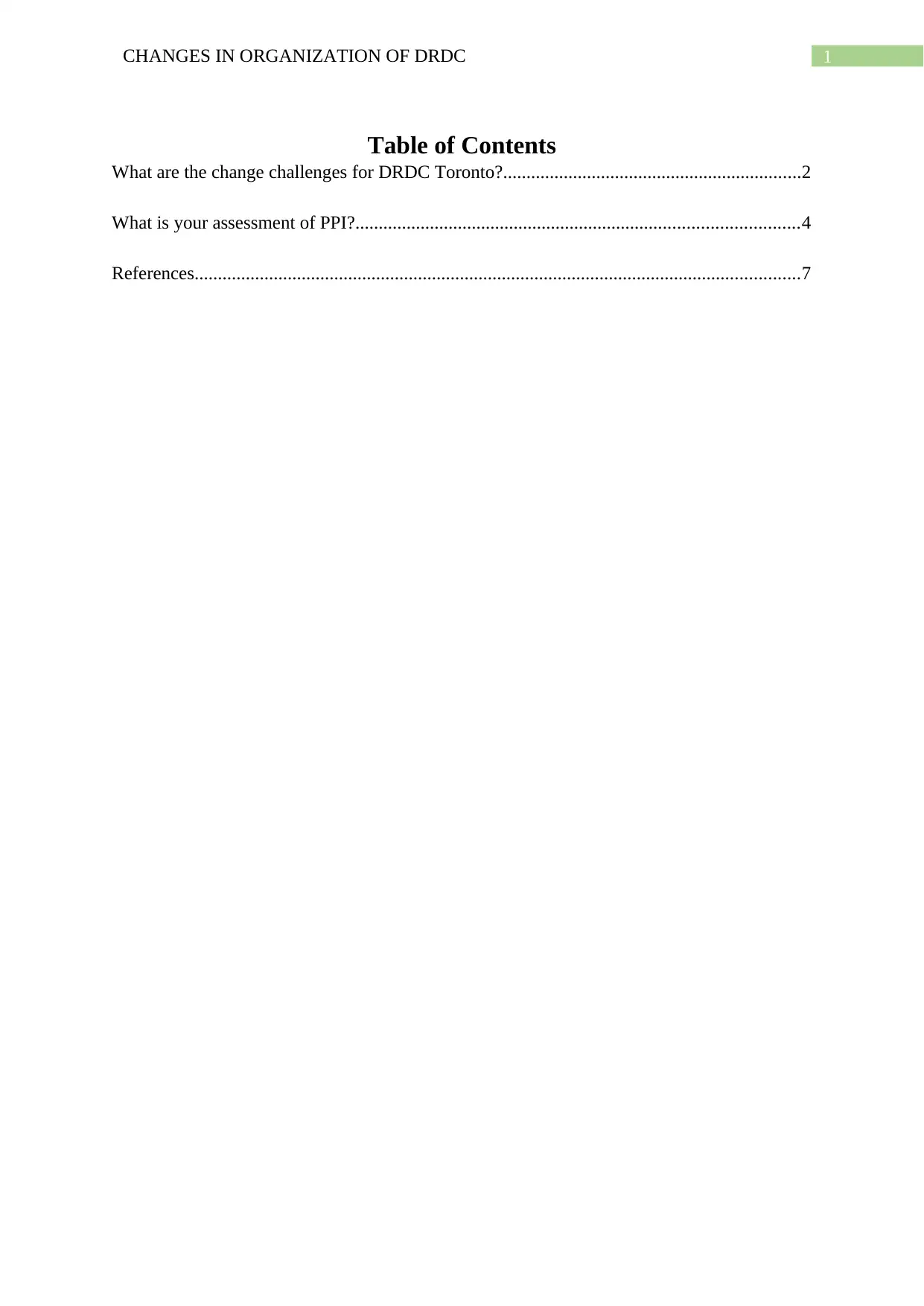
1CHANGES IN ORGANIZATION OF DRDC
Table of Contents
What are the change challenges for DRDC Toronto?................................................................2
What is your assessment of PPI?...............................................................................................4
References..................................................................................................................................7
Table of Contents
What are the change challenges for DRDC Toronto?................................................................2
What is your assessment of PPI?...............................................................................................4
References..................................................................................................................................7
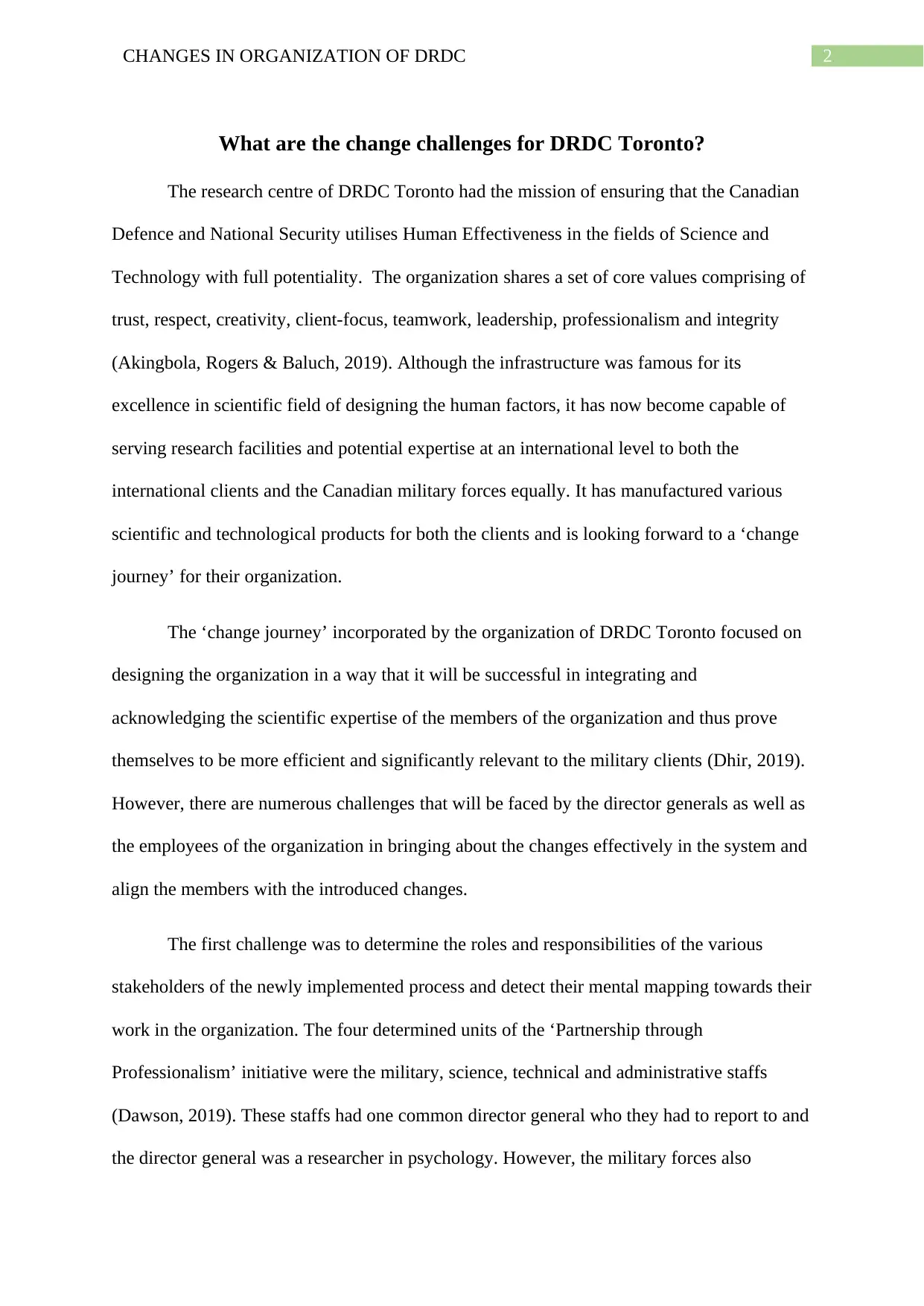
2CHANGES IN ORGANIZATION OF DRDC
What are the change challenges for DRDC Toronto?
The research centre of DRDC Toronto had the mission of ensuring that the Canadian
Defence and National Security utilises Human Effectiveness in the fields of Science and
Technology with full potentiality. The organization shares a set of core values comprising of
trust, respect, creativity, client-focus, teamwork, leadership, professionalism and integrity
(Akingbola, Rogers & Baluch, 2019). Although the infrastructure was famous for its
excellence in scientific field of designing the human factors, it has now become capable of
serving research facilities and potential expertise at an international level to both the
international clients and the Canadian military forces equally. It has manufactured various
scientific and technological products for both the clients and is looking forward to a ‘change
journey’ for their organization.
The ‘change journey’ incorporated by the organization of DRDC Toronto focused on
designing the organization in a way that it will be successful in integrating and
acknowledging the scientific expertise of the members of the organization and thus prove
themselves to be more efficient and significantly relevant to the military clients (Dhir, 2019).
However, there are numerous challenges that will be faced by the director generals as well as
the employees of the organization in bringing about the changes effectively in the system and
align the members with the introduced changes.
The first challenge was to determine the roles and responsibilities of the various
stakeholders of the newly implemented process and detect their mental mapping towards their
work in the organization. The four determined units of the ‘Partnership through
Professionalism’ initiative were the military, science, technical and administrative staffs
(Dawson, 2019). These staffs had one common director general who they had to report to and
the director general was a researcher in psychology. However, the military forces also
What are the change challenges for DRDC Toronto?
The research centre of DRDC Toronto had the mission of ensuring that the Canadian
Defence and National Security utilises Human Effectiveness in the fields of Science and
Technology with full potentiality. The organization shares a set of core values comprising of
trust, respect, creativity, client-focus, teamwork, leadership, professionalism and integrity
(Akingbola, Rogers & Baluch, 2019). Although the infrastructure was famous for its
excellence in scientific field of designing the human factors, it has now become capable of
serving research facilities and potential expertise at an international level to both the
international clients and the Canadian military forces equally. It has manufactured various
scientific and technological products for both the clients and is looking forward to a ‘change
journey’ for their organization.
The ‘change journey’ incorporated by the organization of DRDC Toronto focused on
designing the organization in a way that it will be successful in integrating and
acknowledging the scientific expertise of the members of the organization and thus prove
themselves to be more efficient and significantly relevant to the military clients (Dhir, 2019).
However, there are numerous challenges that will be faced by the director generals as well as
the employees of the organization in bringing about the changes effectively in the system and
align the members with the introduced changes.
The first challenge was to determine the roles and responsibilities of the various
stakeholders of the newly implemented process and detect their mental mapping towards their
work in the organization. The four determined units of the ‘Partnership through
Professionalism’ initiative were the military, science, technical and administrative staffs
(Dawson, 2019). These staffs had one common director general who they had to report to and
the director general was a researcher in psychology. However, the military forces also
You're viewing a preview
Unlock full access by subscribing today!
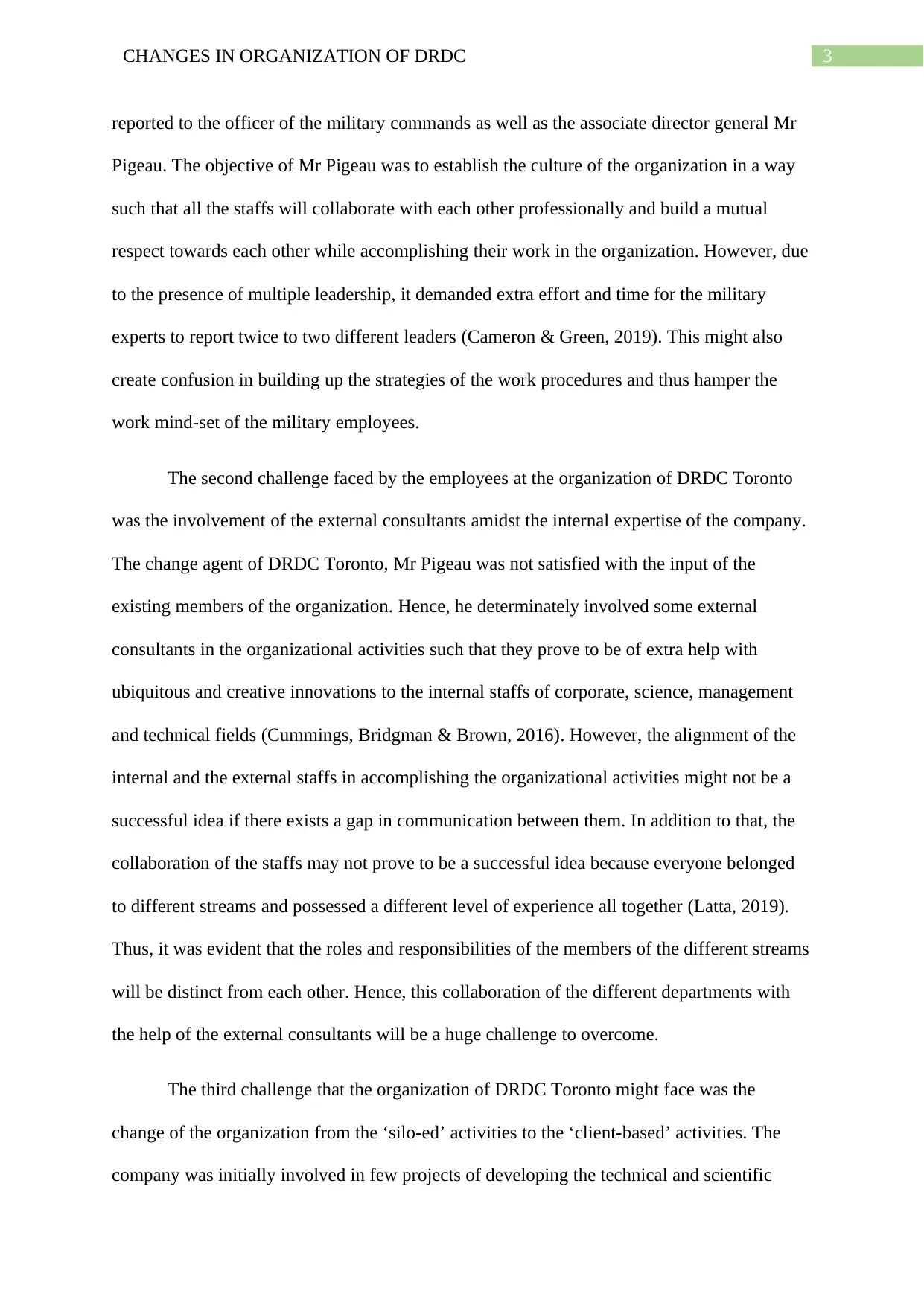
3CHANGES IN ORGANIZATION OF DRDC
reported to the officer of the military commands as well as the associate director general Mr
Pigeau. The objective of Mr Pigeau was to establish the culture of the organization in a way
such that all the staffs will collaborate with each other professionally and build a mutual
respect towards each other while accomplishing their work in the organization. However, due
to the presence of multiple leadership, it demanded extra effort and time for the military
experts to report twice to two different leaders (Cameron & Green, 2019). This might also
create confusion in building up the strategies of the work procedures and thus hamper the
work mind-set of the military employees.
The second challenge faced by the employees at the organization of DRDC Toronto
was the involvement of the external consultants amidst the internal expertise of the company.
The change agent of DRDC Toronto, Mr Pigeau was not satisfied with the input of the
existing members of the organization. Hence, he determinately involved some external
consultants in the organizational activities such that they prove to be of extra help with
ubiquitous and creative innovations to the internal staffs of corporate, science, management
and technical fields (Cummings, Bridgman & Brown, 2016). However, the alignment of the
internal and the external staffs in accomplishing the organizational activities might not be a
successful idea if there exists a gap in communication between them. In addition to that, the
collaboration of the staffs may not prove to be a successful idea because everyone belonged
to different streams and possessed a different level of experience all together (Latta, 2019).
Thus, it was evident that the roles and responsibilities of the members of the different streams
will be distinct from each other. Hence, this collaboration of the different departments with
the help of the external consultants will be a huge challenge to overcome.
The third challenge that the organization of DRDC Toronto might face was the
change of the organization from the ‘silo-ed’ activities to the ‘client-based’ activities. The
company was initially involved in few projects of developing the technical and scientific
reported to the officer of the military commands as well as the associate director general Mr
Pigeau. The objective of Mr Pigeau was to establish the culture of the organization in a way
such that all the staffs will collaborate with each other professionally and build a mutual
respect towards each other while accomplishing their work in the organization. However, due
to the presence of multiple leadership, it demanded extra effort and time for the military
experts to report twice to two different leaders (Cameron & Green, 2019). This might also
create confusion in building up the strategies of the work procedures and thus hamper the
work mind-set of the military employees.
The second challenge faced by the employees at the organization of DRDC Toronto
was the involvement of the external consultants amidst the internal expertise of the company.
The change agent of DRDC Toronto, Mr Pigeau was not satisfied with the input of the
existing members of the organization. Hence, he determinately involved some external
consultants in the organizational activities such that they prove to be of extra help with
ubiquitous and creative innovations to the internal staffs of corporate, science, management
and technical fields (Cummings, Bridgman & Brown, 2016). However, the alignment of the
internal and the external staffs in accomplishing the organizational activities might not be a
successful idea if there exists a gap in communication between them. In addition to that, the
collaboration of the staffs may not prove to be a successful idea because everyone belonged
to different streams and possessed a different level of experience all together (Latta, 2019).
Thus, it was evident that the roles and responsibilities of the members of the different streams
will be distinct from each other. Hence, this collaboration of the different departments with
the help of the external consultants will be a huge challenge to overcome.
The third challenge that the organization of DRDC Toronto might face was the
change of the organization from the ‘silo-ed’ activities to the ‘client-based’ activities. The
company was initially involved in few projects of developing the technical and scientific
Paraphrase This Document
Need a fresh take? Get an instant paraphrase of this document with our AI Paraphraser
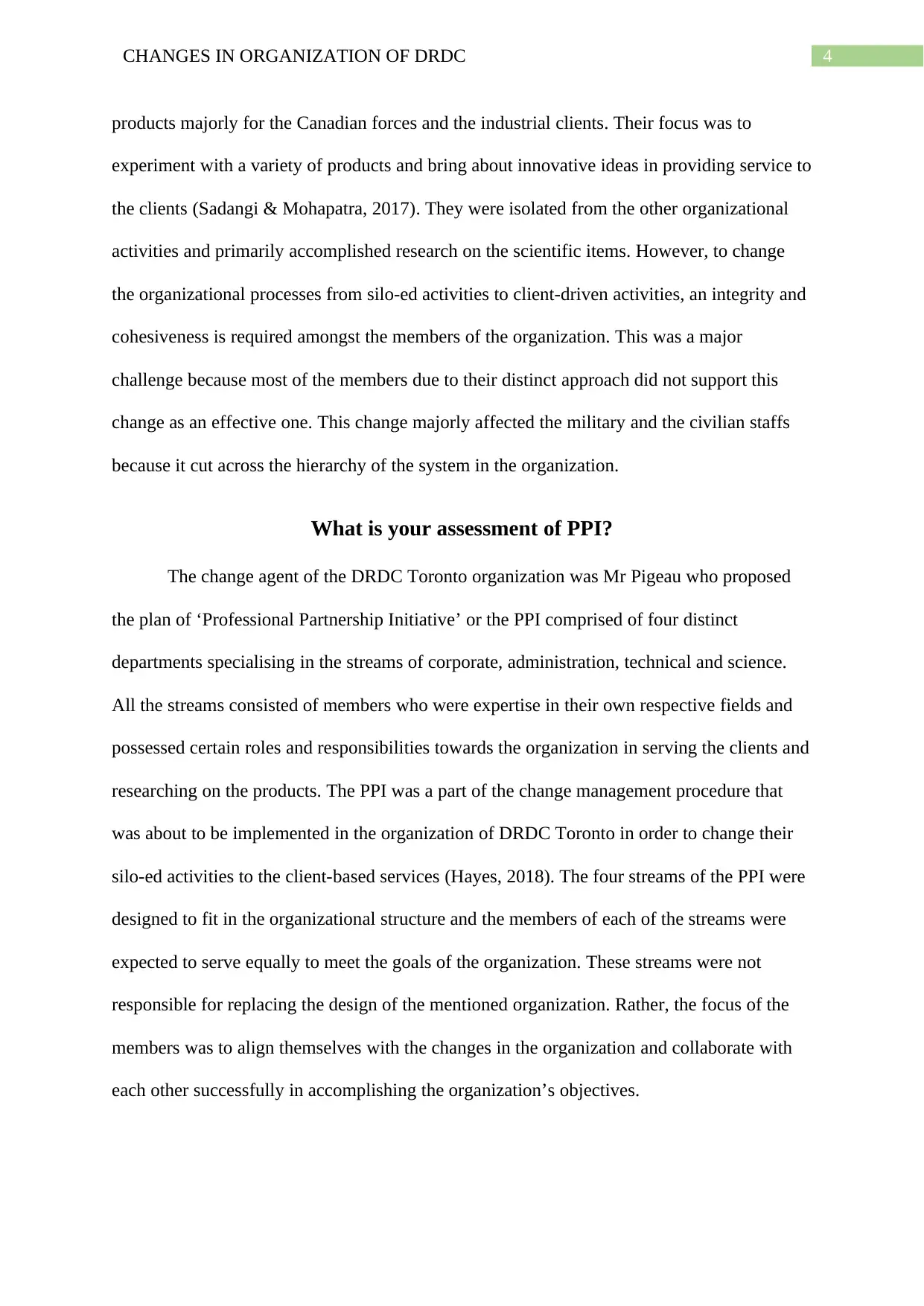
4CHANGES IN ORGANIZATION OF DRDC
products majorly for the Canadian forces and the industrial clients. Their focus was to
experiment with a variety of products and bring about innovative ideas in providing service to
the clients (Sadangi & Mohapatra, 2017). They were isolated from the other organizational
activities and primarily accomplished research on the scientific items. However, to change
the organizational processes from silo-ed activities to client-driven activities, an integrity and
cohesiveness is required amongst the members of the organization. This was a major
challenge because most of the members due to their distinct approach did not support this
change as an effective one. This change majorly affected the military and the civilian staffs
because it cut across the hierarchy of the system in the organization.
What is your assessment of PPI?
The change agent of the DRDC Toronto organization was Mr Pigeau who proposed
the plan of ‘Professional Partnership Initiative’ or the PPI comprised of four distinct
departments specialising in the streams of corporate, administration, technical and science.
All the streams consisted of members who were expertise in their own respective fields and
possessed certain roles and responsibilities towards the organization in serving the clients and
researching on the products. The PPI was a part of the change management procedure that
was about to be implemented in the organization of DRDC Toronto in order to change their
silo-ed activities to the client-based services (Hayes, 2018). The four streams of the PPI were
designed to fit in the organizational structure and the members of each of the streams were
expected to serve equally to meet the goals of the organization. These streams were not
responsible for replacing the design of the mentioned organization. Rather, the focus of the
members was to align themselves with the changes in the organization and collaborate with
each other successfully in accomplishing the organization’s objectives.
products majorly for the Canadian forces and the industrial clients. Their focus was to
experiment with a variety of products and bring about innovative ideas in providing service to
the clients (Sadangi & Mohapatra, 2017). They were isolated from the other organizational
activities and primarily accomplished research on the scientific items. However, to change
the organizational processes from silo-ed activities to client-driven activities, an integrity and
cohesiveness is required amongst the members of the organization. This was a major
challenge because most of the members due to their distinct approach did not support this
change as an effective one. This change majorly affected the military and the civilian staffs
because it cut across the hierarchy of the system in the organization.
What is your assessment of PPI?
The change agent of the DRDC Toronto organization was Mr Pigeau who proposed
the plan of ‘Professional Partnership Initiative’ or the PPI comprised of four distinct
departments specialising in the streams of corporate, administration, technical and science.
All the streams consisted of members who were expertise in their own respective fields and
possessed certain roles and responsibilities towards the organization in serving the clients and
researching on the products. The PPI was a part of the change management procedure that
was about to be implemented in the organization of DRDC Toronto in order to change their
silo-ed activities to the client-based services (Hayes, 2018). The four streams of the PPI were
designed to fit in the organizational structure and the members of each of the streams were
expected to serve equally to meet the goals of the organization. These streams were not
responsible for replacing the design of the mentioned organization. Rather, the focus of the
members was to align themselves with the changes in the organization and collaborate with
each other successfully in accomplishing the organization’s objectives.
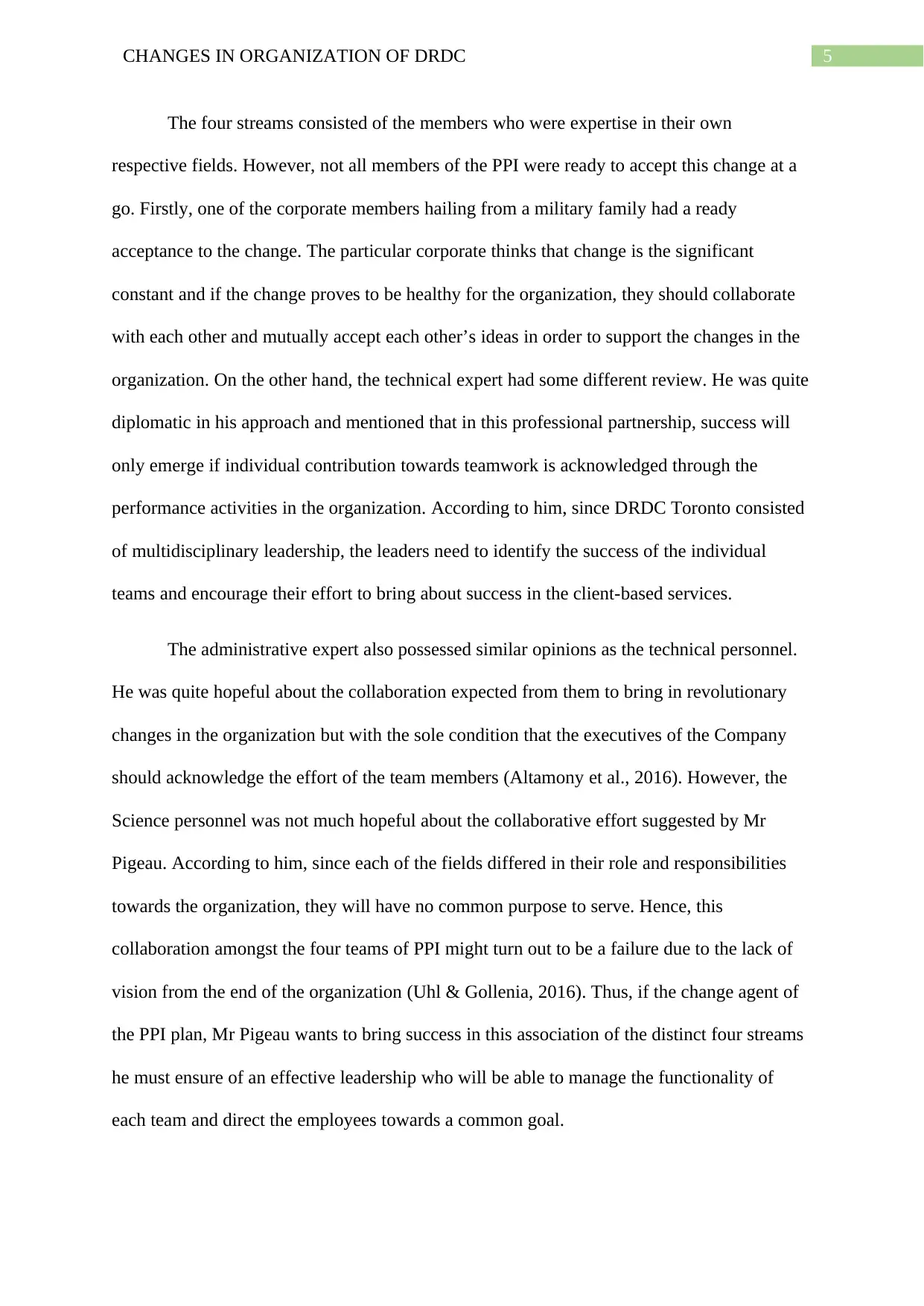
5CHANGES IN ORGANIZATION OF DRDC
The four streams consisted of the members who were expertise in their own
respective fields. However, not all members of the PPI were ready to accept this change at a
go. Firstly, one of the corporate members hailing from a military family had a ready
acceptance to the change. The particular corporate thinks that change is the significant
constant and if the change proves to be healthy for the organization, they should collaborate
with each other and mutually accept each other’s ideas in order to support the changes in the
organization. On the other hand, the technical expert had some different review. He was quite
diplomatic in his approach and mentioned that in this professional partnership, success will
only emerge if individual contribution towards teamwork is acknowledged through the
performance activities in the organization. According to him, since DRDC Toronto consisted
of multidisciplinary leadership, the leaders need to identify the success of the individual
teams and encourage their effort to bring about success in the client-based services.
The administrative expert also possessed similar opinions as the technical personnel.
He was quite hopeful about the collaboration expected from them to bring in revolutionary
changes in the organization but with the sole condition that the executives of the Company
should acknowledge the effort of the team members (Altamony et al., 2016). However, the
Science personnel was not much hopeful about the collaborative effort suggested by Mr
Pigeau. According to him, since each of the fields differed in their role and responsibilities
towards the organization, they will have no common purpose to serve. Hence, this
collaboration amongst the four teams of PPI might turn out to be a failure due to the lack of
vision from the end of the organization (Uhl & Gollenia, 2016). Thus, if the change agent of
the PPI plan, Mr Pigeau wants to bring success in this association of the distinct four streams
he must ensure of an effective leadership who will be able to manage the functionality of
each team and direct the employees towards a common goal.
The four streams consisted of the members who were expertise in their own
respective fields. However, not all members of the PPI were ready to accept this change at a
go. Firstly, one of the corporate members hailing from a military family had a ready
acceptance to the change. The particular corporate thinks that change is the significant
constant and if the change proves to be healthy for the organization, they should collaborate
with each other and mutually accept each other’s ideas in order to support the changes in the
organization. On the other hand, the technical expert had some different review. He was quite
diplomatic in his approach and mentioned that in this professional partnership, success will
only emerge if individual contribution towards teamwork is acknowledged through the
performance activities in the organization. According to him, since DRDC Toronto consisted
of multidisciplinary leadership, the leaders need to identify the success of the individual
teams and encourage their effort to bring about success in the client-based services.
The administrative expert also possessed similar opinions as the technical personnel.
He was quite hopeful about the collaboration expected from them to bring in revolutionary
changes in the organization but with the sole condition that the executives of the Company
should acknowledge the effort of the team members (Altamony et al., 2016). However, the
Science personnel was not much hopeful about the collaborative effort suggested by Mr
Pigeau. According to him, since each of the fields differed in their role and responsibilities
towards the organization, they will have no common purpose to serve. Hence, this
collaboration amongst the four teams of PPI might turn out to be a failure due to the lack of
vision from the end of the organization (Uhl & Gollenia, 2016). Thus, if the change agent of
the PPI plan, Mr Pigeau wants to bring success in this association of the distinct four streams
he must ensure of an effective leadership who will be able to manage the functionality of
each team and direct the employees towards a common goal.
You're viewing a preview
Unlock full access by subscribing today!
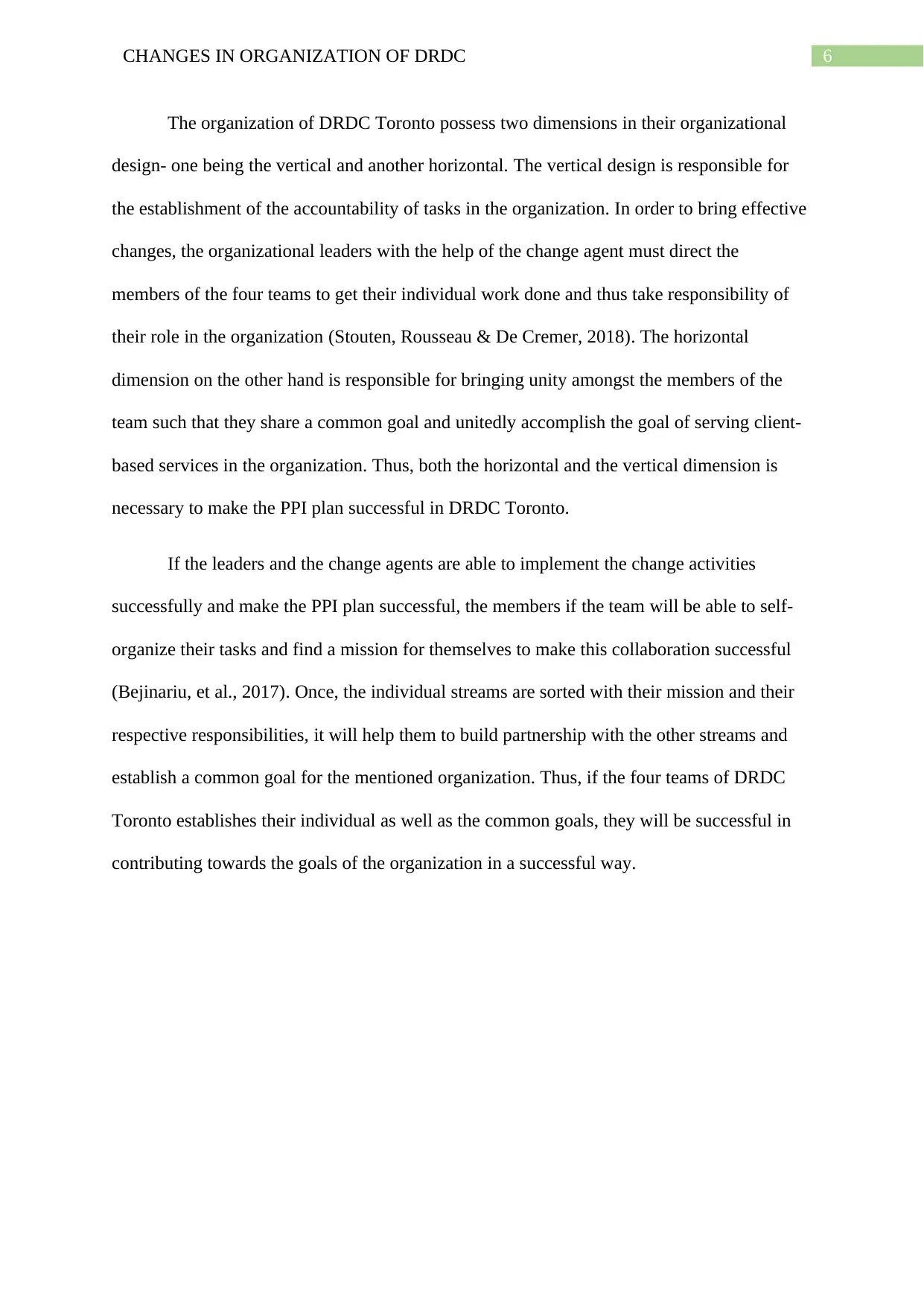
6CHANGES IN ORGANIZATION OF DRDC
The organization of DRDC Toronto possess two dimensions in their organizational
design- one being the vertical and another horizontal. The vertical design is responsible for
the establishment of the accountability of tasks in the organization. In order to bring effective
changes, the organizational leaders with the help of the change agent must direct the
members of the four teams to get their individual work done and thus take responsibility of
their role in the organization (Stouten, Rousseau & De Cremer, 2018). The horizontal
dimension on the other hand is responsible for bringing unity amongst the members of the
team such that they share a common goal and unitedly accomplish the goal of serving client-
based services in the organization. Thus, both the horizontal and the vertical dimension is
necessary to make the PPI plan successful in DRDC Toronto.
If the leaders and the change agents are able to implement the change activities
successfully and make the PPI plan successful, the members if the team will be able to self-
organize their tasks and find a mission for themselves to make this collaboration successful
(Bejinariu, et al., 2017). Once, the individual streams are sorted with their mission and their
respective responsibilities, it will help them to build partnership with the other streams and
establish a common goal for the mentioned organization. Thus, if the four teams of DRDC
Toronto establishes their individual as well as the common goals, they will be successful in
contributing towards the goals of the organization in a successful way.
The organization of DRDC Toronto possess two dimensions in their organizational
design- one being the vertical and another horizontal. The vertical design is responsible for
the establishment of the accountability of tasks in the organization. In order to bring effective
changes, the organizational leaders with the help of the change agent must direct the
members of the four teams to get their individual work done and thus take responsibility of
their role in the organization (Stouten, Rousseau & De Cremer, 2018). The horizontal
dimension on the other hand is responsible for bringing unity amongst the members of the
team such that they share a common goal and unitedly accomplish the goal of serving client-
based services in the organization. Thus, both the horizontal and the vertical dimension is
necessary to make the PPI plan successful in DRDC Toronto.
If the leaders and the change agents are able to implement the change activities
successfully and make the PPI plan successful, the members if the team will be able to self-
organize their tasks and find a mission for themselves to make this collaboration successful
(Bejinariu, et al., 2017). Once, the individual streams are sorted with their mission and their
respective responsibilities, it will help them to build partnership with the other streams and
establish a common goal for the mentioned organization. Thus, if the four teams of DRDC
Toronto establishes their individual as well as the common goals, they will be successful in
contributing towards the goals of the organization in a successful way.
Paraphrase This Document
Need a fresh take? Get an instant paraphrase of this document with our AI Paraphraser
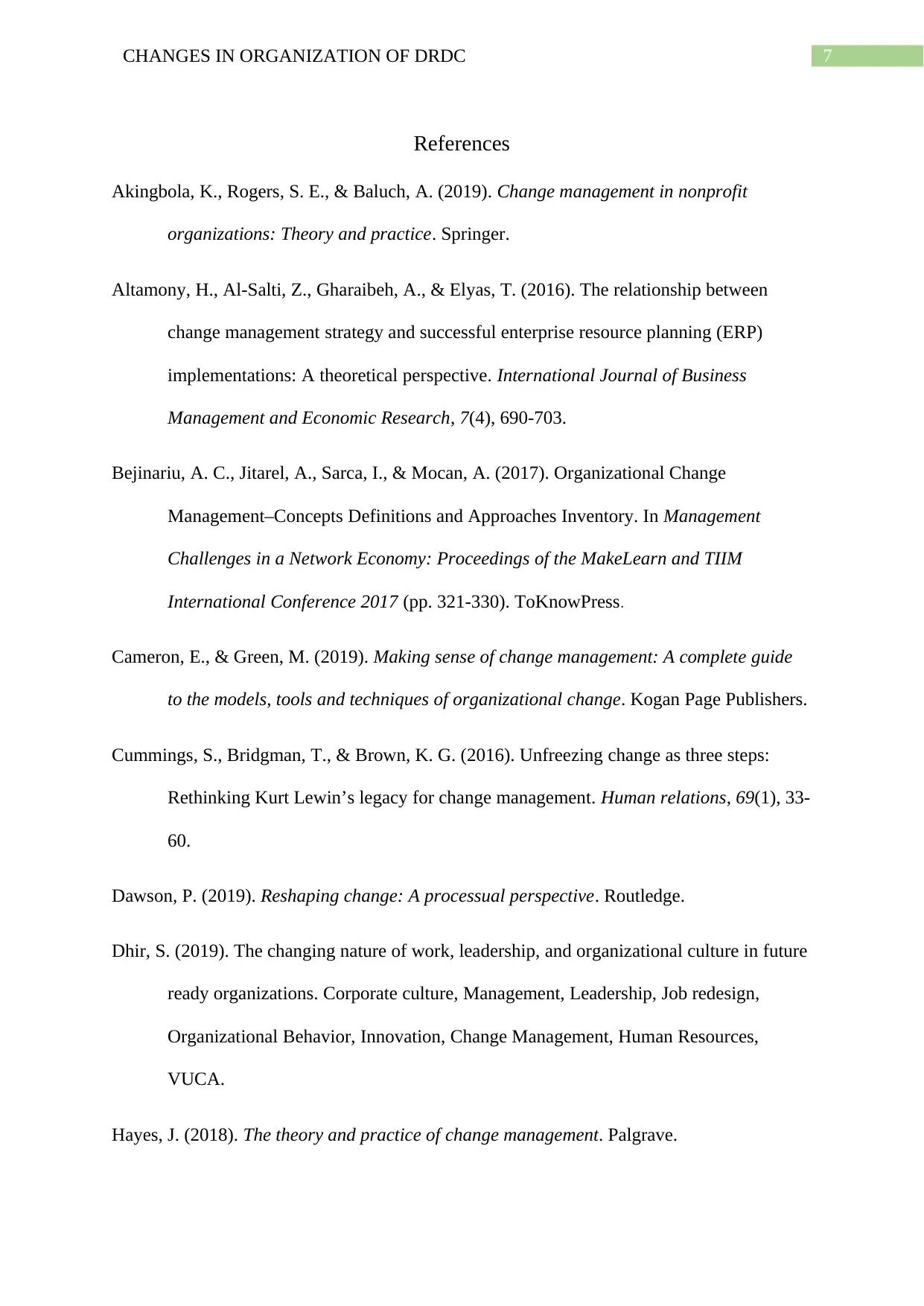
7CHANGES IN ORGANIZATION OF DRDC
References
Akingbola, K., Rogers, S. E., & Baluch, A. (2019). Change management in nonprofit
organizations: Theory and practice. Springer.
Altamony, H., Al-Salti, Z., Gharaibeh, A., & Elyas, T. (2016). The relationship between
change management strategy and successful enterprise resource planning (ERP)
implementations: A theoretical perspective. International Journal of Business
Management and Economic Research, 7(4), 690-703.
Bejinariu, A. C., Jitarel, A., Sarca, I., & Mocan, A. (2017). Organizational Change
Management–Concepts Definitions and Approaches Inventory. In Management
Challenges in a Network Economy: Proceedings of the MakeLearn and TIIM
International Conference 2017 (pp. 321-330). ToKnowPress.
Cameron, E., & Green, M. (2019). Making sense of change management: A complete guide
to the models, tools and techniques of organizational change. Kogan Page Publishers.
Cummings, S., Bridgman, T., & Brown, K. G. (2016). Unfreezing change as three steps:
Rethinking Kurt Lewin’s legacy for change management. Human relations, 69(1), 33-
60.
Dawson, P. (2019). Reshaping change: A processual perspective. Routledge.
Dhir, S. (2019). The changing nature of work, leadership, and organizational culture in future
ready organizations. Corporate culture, Management, Leadership, Job redesign,
Organizational Behavior, Innovation, Change Management, Human Resources,
VUCA.
Hayes, J. (2018). The theory and practice of change management. Palgrave.
References
Akingbola, K., Rogers, S. E., & Baluch, A. (2019). Change management in nonprofit
organizations: Theory and practice. Springer.
Altamony, H., Al-Salti, Z., Gharaibeh, A., & Elyas, T. (2016). The relationship between
change management strategy and successful enterprise resource planning (ERP)
implementations: A theoretical perspective. International Journal of Business
Management and Economic Research, 7(4), 690-703.
Bejinariu, A. C., Jitarel, A., Sarca, I., & Mocan, A. (2017). Organizational Change
Management–Concepts Definitions and Approaches Inventory. In Management
Challenges in a Network Economy: Proceedings of the MakeLearn and TIIM
International Conference 2017 (pp. 321-330). ToKnowPress.
Cameron, E., & Green, M. (2019). Making sense of change management: A complete guide
to the models, tools and techniques of organizational change. Kogan Page Publishers.
Cummings, S., Bridgman, T., & Brown, K. G. (2016). Unfreezing change as three steps:
Rethinking Kurt Lewin’s legacy for change management. Human relations, 69(1), 33-
60.
Dawson, P. (2019). Reshaping change: A processual perspective. Routledge.
Dhir, S. (2019). The changing nature of work, leadership, and organizational culture in future
ready organizations. Corporate culture, Management, Leadership, Job redesign,
Organizational Behavior, Innovation, Change Management, Human Resources,
VUCA.
Hayes, J. (2018). The theory and practice of change management. Palgrave.
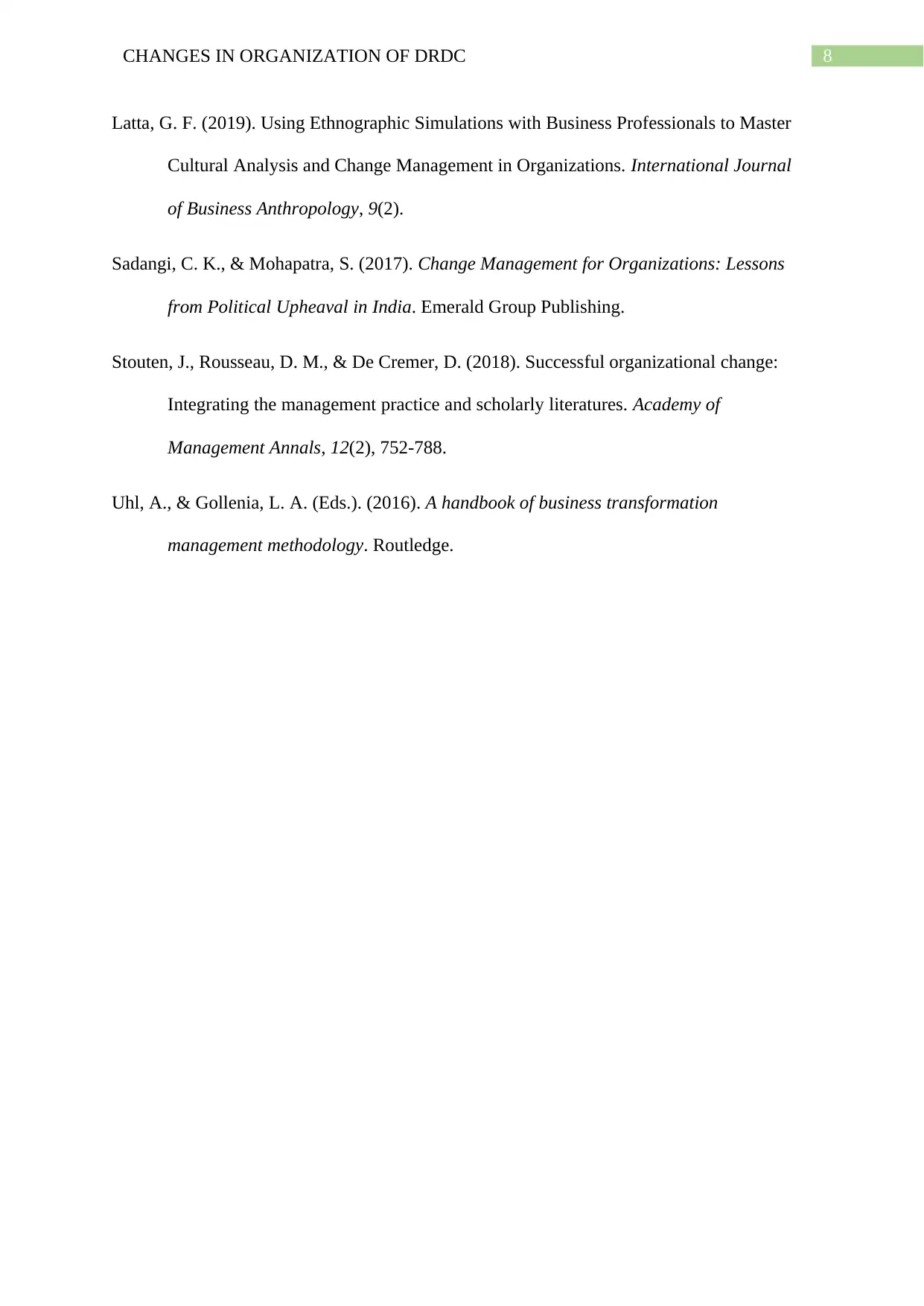
8CHANGES IN ORGANIZATION OF DRDC
Latta, G. F. (2019). Using Ethnographic Simulations with Business Professionals to Master
Cultural Analysis and Change Management in Organizations. International Journal
of Business Anthropology, 9(2).
Sadangi, C. K., & Mohapatra, S. (2017). Change Management for Organizations: Lessons
from Political Upheaval in India. Emerald Group Publishing.
Stouten, J., Rousseau, D. M., & De Cremer, D. (2018). Successful organizational change:
Integrating the management practice and scholarly literatures. Academy of
Management Annals, 12(2), 752-788.
Uhl, A., & Gollenia, L. A. (Eds.). (2016). A handbook of business transformation
management methodology. Routledge.
Latta, G. F. (2019). Using Ethnographic Simulations with Business Professionals to Master
Cultural Analysis and Change Management in Organizations. International Journal
of Business Anthropology, 9(2).
Sadangi, C. K., & Mohapatra, S. (2017). Change Management for Organizations: Lessons
from Political Upheaval in India. Emerald Group Publishing.
Stouten, J., Rousseau, D. M., & De Cremer, D. (2018). Successful organizational change:
Integrating the management practice and scholarly literatures. Academy of
Management Annals, 12(2), 752-788.
Uhl, A., & Gollenia, L. A. (Eds.). (2016). A handbook of business transformation
management methodology. Routledge.
You're viewing a preview
Unlock full access by subscribing today!
1 out of 9
Related Documents
Your All-in-One AI-Powered Toolkit for Academic Success.
+13062052269
info@desklib.com
Available 24*7 on WhatsApp / Email
![[object Object]](/_next/static/media/star-bottom.7253800d.svg)
Unlock your academic potential
© 2024 | Zucol Services PVT LTD | All rights reserved.





